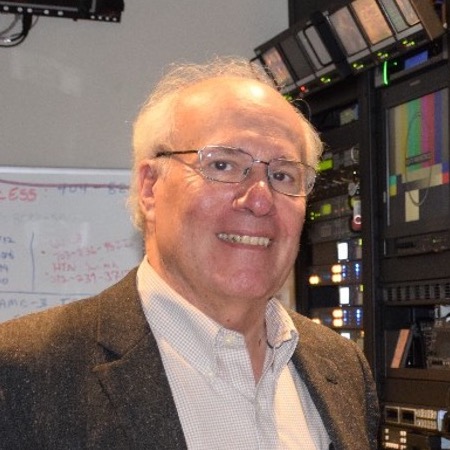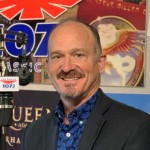We wanted to know what technologists in our industry are excited about and expect or hope to see in 2025, so we asked the NAB Technology staff and a few other luminaries in the industry if they had anything to share. They did. This compilation is our way of wrapping up 2024 by looking forward to 2025.

Software Implementations of EAS
More and more, the technology used to create broadcast content is based on software implementations run on local servers and less upon separate, purpose-built, rack-mounted pieces of hardware. FCC-required EAS encoder/decoders, used by stations to receive and rebroadcast EAS messages, are an exception to this, making it more difficult for broadcasters to realize the full benefits of software-based systems.
NAB has been working with its members, the FCC, FEMA, EAS equipment manufacturers, and others to free broadcaster from the regulatory obligation to own a physical “EAS box” and identify software-based architectures that preserve the integrity of EAS operations. This would allow for greatly improved redundancy and reporting capabilities, streamlined operations and potential long-term cost savings for broadcasters. I am excited to see this progress and believe that in 2025 systems will be developed that achieve this and hope the FCC will update its rules to enable the use of software-based EAS by broadcasters.
Leveraging First-Party Data to Reignite Listener Engagement
In 2025, first-party data will continue to grow as a critical tool for broadcasters to better understand consumer behaviors and rekindle connections with lapsed audiences. By analyzing consumer habits, preferences, and engagement patterns, broadcasters will identify trends and leverage insights to address evolving audience needs. Combining this data with AI-driven insights will enable broadcasters to predict consumer behavior, offer well-timed reminders, and create personalized re-engagement campaigns. Whether it’s nudging a lapsed listener with incentives or delivering exclusive, targeted content, first-party data will empower broadcasters to foster loyalty, increase consumption, and maintain a strong presence in a data-driven world.
Electric Cars: A Broadcast Allegory?
I’m getting excited about the eventual transition to all-electric vehicles. There are a lot of moving parts to the transition, but 2025 could be the year that a definitized switchover plan from gas to electric vehicles is mapped out. Perhaps it can also serve as a template for another large-scale transition currently taking place…
First of all, ubiquitous availability of vehicle charging stations will be needed, which will likely be located at existing gas stations. For gas station owners to really get the transition going, this means they will initially need to apportion some of their existing space and infrastructure for charging stations since there is unlikely to be more real estate available to expand the existing footprint of the gas stations. Perhaps gas stations in metropolitan areas will cooperate and implement charging stations initially at one station in the neighborhood (called an electric lighthouse?) and share the costs among the gas station owners for operating it. For some period of time, they will then need to supply both gas and electric charging, but both services will be handicapped since they are providing two services using their existing finite amount of real estate.
Eventually, the plan will be to get rid of the gas pumps and go to all-electric charging. But that will only be practical when the large majority of consumers have all bought in to the benefits of electric vehicles and buy new electric cars or trucks. Should the industry lobby the government to provide certainty that this will happen via a voluntary or mandated gas-switch-off date and/or a phased-in electrical vehicle requirement? One alternative to avoid disenfranchising any remaining consumers with gas vehicles might be to develop an inexpensive add-on device that will power legacy gasoline engines using electricity. In any case, gas stations should not be required to provide both gas and charging stations forever!
On the vehicle production side, manufacturing plants could be modified on a phased-in basis such that eventually all vehicles manufactured for sale in the U.S. will be electric and car dealers will be tasked to explain the benefits of all-electric vehicles to consumers and clear up any confusion or misconceptions about the change in the car powering system. Similarly, electric charging stations will eventually take over the real estate and operations of the old gas stations and fossil fuel will no longer be needed. Life will be good then, since the overall benefits of the new technology far outweigh those of the old technology. Consumers may be satisfied now, but they are not truly happy, and they don’t yet know the difference. Let’s get the transition planning done in 2025!
We Are the Heroes We’ve Been Waiting For
As 2024 draws to a close, many colleagues mourn a particularly bloody year of personnel reductions that have cut deeply into the bones of the broadcast industry. While this is sad and difficult, it also presents new opportunities for broadcast technologists. Perhaps 2024 has provided a clarion call that an overdue paradigm shift is occurring in the way broadcast technologists support broadcast stations.
While our industry has so meaningfully rallied this year to save AM in vehicles, it seems imperative to also ask “but how will AM broadcasting reach those dashboards if AM broadcasters have released the engineers who keep their stations on the air?” FM is in the same boat.
There are too few broadcast engineers still in the industry and economic conditions have deteriorated to the point where stations can no longer afford meaningful technology staffs. We must change.
In order to provide fulfilling careers, continue upskilling and support, and provide stability in the lives of technologists, the time has come to band together and work in groups outside of broadcast companies. In this new model, we will be able to support one another, provide career growth, deliver healthy work/life balance and good salaries, while developing new ways to deliver stability and mission-critical services to an industry who still needs our skills, even as it continues to shift.
I think 2025 will be the year where this model picks up steam in response to 2024. Organizations will emerge to provide new career paths for the broadcast technologists who will continue to power this industry. The days of engineers working directly for stations are numbered, and in many cases, they are already gone.
Opportunity abounds for those willing to step into the discomfort of this paradigm shift, learn to work in new ways, and come together for the benefit of our industry and of our profession. There is still hope and joy and career fulfillment to be found in broadcast engineering – though we need to muster the strength to wade through the cold, murky river of change to make it to the other side. Our industry still needs us, and we need each other more than ever. We are the heroes we’ve been waiting for.
 Rob Bertrand
Rob BertrandVice-Chair, NAB Radio Technology Committee
Building on Success – 2025 a Good Time for ATSC 3.0
2025 will be a significant year for ATSC 3.0 that will build on the successes of 2024. Some of those include:
- Six new market launches and over 75% market coverage of USTVHH
- Broad Deployment of HDR (almost 200 channels), including by NBC for the Paris Olympics
- New NEXTGEN TV model launches by TCL and Panasonic
- Brazil’s adoption of ATSC 3.0
- BPSTM deployments at three full power stations in the U.S.
For 2025, a more conducive regulatory environment in the U.S. will enable broadcasters to deploy NEXTGEN TV at a faster pace and encourage even greater support from the consumer electronics industry. All of this will set the stage for a complete transition in the years ahead that will unlock significant consumer and economic benefits sooner than otherwise possible. 2025 will see BPS deployed and tested in multiple countries including the U.S. Canada, and the Republic of Korea. These deployments will further prove how ATSC 3.0 and BPS can enhance the resiliency of GPS and enhance national and economic security.
What are the AI Tools Yet to Come?
Heading into 2025, I’m excited to test all the AI tools that I’ve not yet had a chance to try or that aren’t even currently available (or developed). It feels a bit like the late 1990s and early 2000s when we were playing with all the interesting ways to put web tools to use. Learning to use Flash, Shockwave, Perl, and even Dreamweaver (although nothing could beat Notepad) was fun and enlightening. What are the best AI tools for individual productivity? How will the use of these tools impact the way I approach everyday tasks? Figuring out how to appropriately and effectively use new technology has always been interesting and personally fulfilling. I’ve had a chance to use different AI tools, but I can’t help but think about what will be available and refined in 2025 as development expands.
Reaching for the Moonshot of Personalized Media
For decades, the vision of building a one-to-one relationship with consumers has been a “moonshot” for our industry. As news and media consumption become increasingly commoditized by advancements in AI, search, advertising, and social media, the demand for authenticity, relevance, and trust has never been stronger.
2025 marks a pivotal moment for broadcasters to embrace and adapt transformative technologies, fostering deeper, more personal connections with their audiences. With the convergence of real-time technologies, scalable cloud infrastructure, advanced AI, and seamless connectivity, we are uniquely positioned to bring our distinctive voice, creativity, and storytelling closer to each individual, reshaping how media is experienced and valued.
 Sun Sachs
Sun SachsSenior Vice President of Product, Design and Engineering, BEIT Committee Chair, NAB Digital Officer Committee
Next Generation Audiences
My thoughts don’t go to a new technology, per se, but rather a recognition of how audiences use technology for their information needs. As more Americans continue to get their news from TV and radio over print, broadcasters will remain critical to the news ecosystem in 2025. And I’m seeing more and more broadcasters truly digest what the research has been showing for several years: younger audiences operate differently. I’ve found the recent Next Gen News and Reuters Digital News research full of insights about how younger generations are consuming media. I see huge value in content providers seeking to deeply understand these trends. I share the opinion of many in the industry that meeting audiences where they are and adapting to those changing habits is a more useful pursuit than focusing on how we think users “should” consume media, news or otherwise.
Broadcast Positioning System (BPSTM ): Providing an important public service using ATSC 3.0 transmission path.
Broadcasters understand the many advantages that ATSC 3.0 offers, including more operational flexibility, greater signal reliability, High Dynamic Range video (HDR), emergency notification and others. BPSTM is another exciting application that can be easily integrated into ATSC 3.0 stations to provide a critical and complementary service for GPS time and navigation. Proof-of-concept testing and evaluation is now underway at three ATSC 3.0 stations in Washington, D.C.; Baltimore, Md.; and Denver, Colo. This exciting new technology has the potential to provide a significant public service that was not envisioned when ATSC 3.0 was adopted as the NextGen standard. ATSC flexibility using BPS is another great attribute of NEXTGEN TV. We are looking forward to further development of BPSTM in 2025.
 Harvey Arnold
Harvey ArnoldSVP of Engineering, Sinclair Broadcast Group, Chair, NAB TV Technology Committee
The Broadcast Technology Evolution Continues
2024 reminded us that the communities we serve rely on radio to deliver critical information during times of disaster, and the time-proven methods of communicating the information, such as AM radio, are critical to maintain. 2025 will be a transformative year for radio broadcast technology as developments in AI, hybrid radio, software solutions for modernization of infrastructure and developments in reliable content distribution are implemented. Once again, broadcast technology solutions will enable radio to evolve by improving the resiliency of broadcast infrastructure and further increasing communities’ confidence that their needs will be met.
Broadcast Positioning SystemTM (BPSTM)
I am very excited and bullish about ATSC 3.0 based BPSTM that has been deployed in Washington, D.C.; Denver, CO, and Baltimore, Md. Scientists at NIST have been testing BPSTM time delivery capabilities. DHS has studied the robustness of BPSTM service for survivability against loss of GPS satellites. TV broadcasters have recognized BPSTM ’s strategic importance in advancing ATSC 3.0 deployment. In 2025, I think that the US government will fund at least one test to study BPSTM. I am confident that the NIST scientists will find BPSTM ’s time delivery capabilities as stable as those of GPS. New and more capable BPSTM receivers will be available in 2025. BPS trials will also pick up steam in Canada. With a NOC to monitor real-time time synchronization of the TV towers, I believe that BPSTM will be recognized as an emerging PNT service in the U.S.









